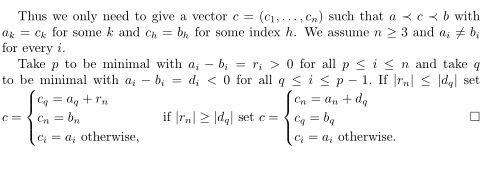For two positive vectors $a,b$ such that $a\prec b$, we know that there is an $m$ sequence of vectors $c^{(i)}$ such that $$a\prec c^{(1)}\prec \ldots \prec c^{(m)}\prec b$$ where each vector in the precedent formula differs from its successor by two entries. This is a classic result. I hope i don't need to explicit the algorithm. See
*{A. W. Marshall,I. Olkin, B. C. Arnold, Inequalities: Theory of Majorization and Its Applications}.*
Usually the process begins from $b$ to arrive at $a$, i guess i found a way to start from $a$ and arrive at $b$ and by some «example verification» i obtained the same sequence $c^{(i)}$. For example in the literature they first obtain $c^{(m)}$ and i obtain first $c^{(1)}$. Before expliciting the small process can anyone justify or obtain a similar algorithm, how to get first $c^{(1)}$ then $c^{(2)}$ and finally $b$.
I'll post the route if everything is clear. The question is for justification not more.
Here are the two algorithms the first is the one found in many books the second is what i thought of. The vectors are arranged in decreasing order. The vector $a$ is $x$ and $b$ is $y$. $y^*$ is $c^{(m)}$ and $c$ is $c^{(1)}$. If you repeat the same algorithm applied to $a\prec c^{(m)}$ you obtain $c^{(m-1)}$
until you get $a$, whether if you apply the second (at each step delete the equal entries) you get first $c^{(1)}$ and then repeatedly arrive at $b$. Can someone tell why?
